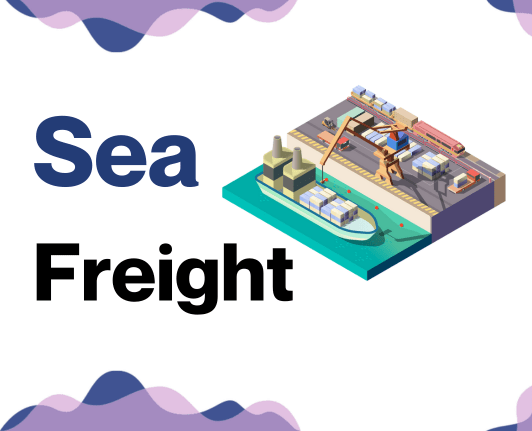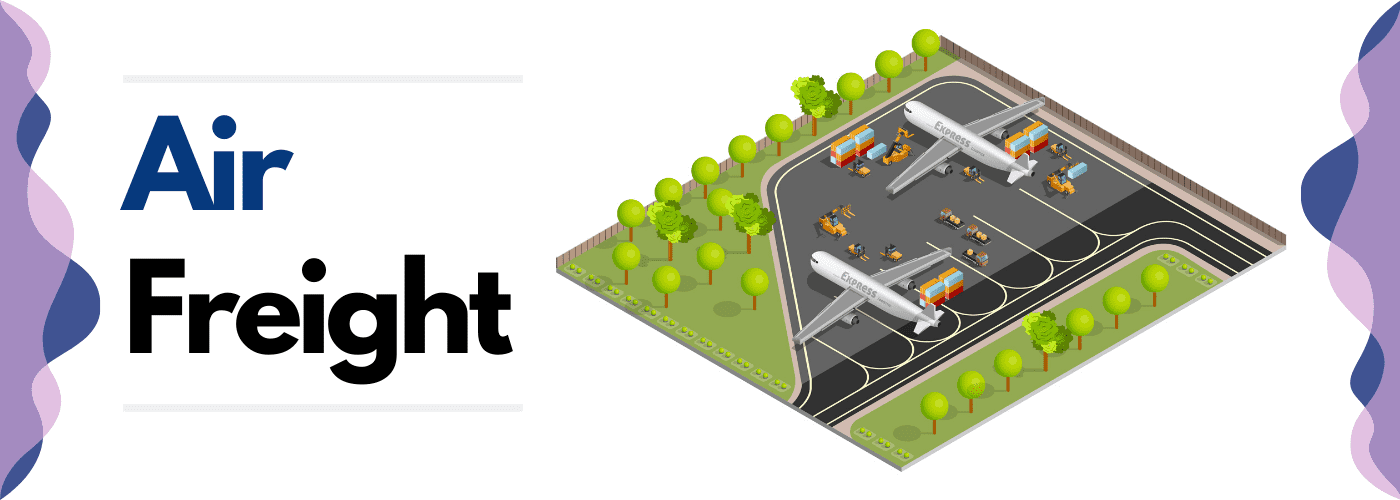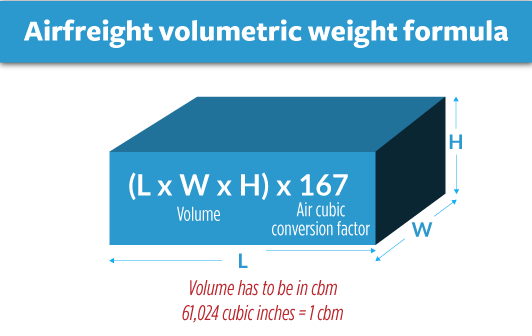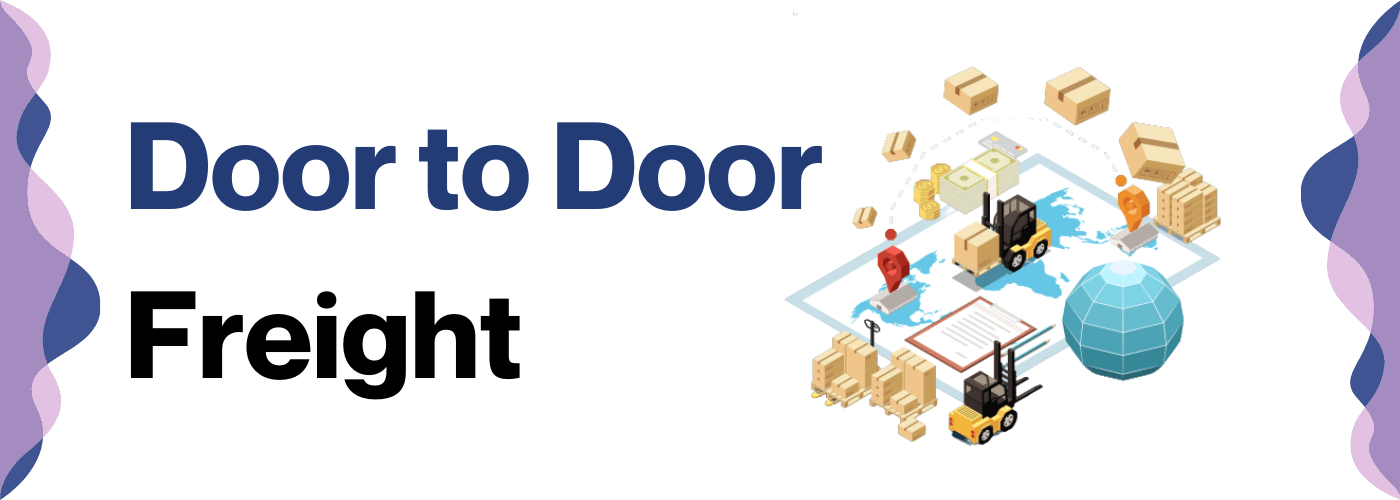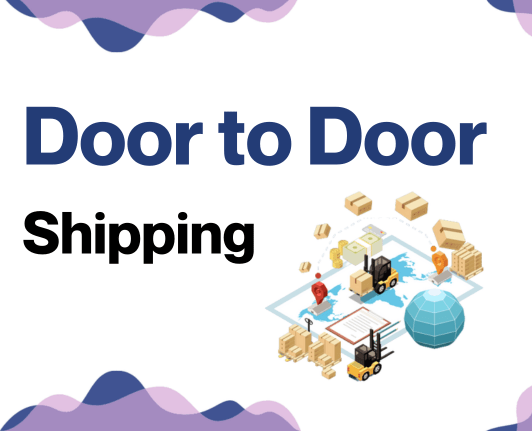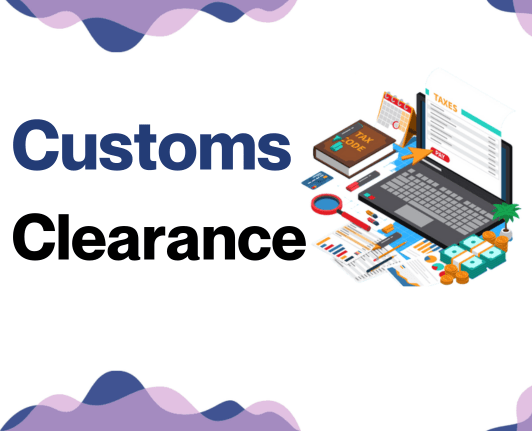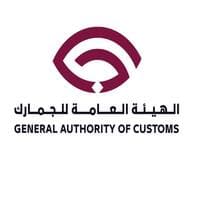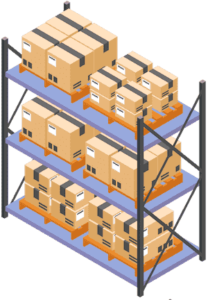Did you hear about the exporter who forgot his shipment's destination? He said his memory Qatarway!
Shipping goods between Qatar and Pakistan can feel just as profounding, with obstacles such as deciphering rates, dealing with transit times and digging through customs regulations.
Our destination guide aims to provide a clear roadmap; demystifying each step of the international freight process – discussing all your freight options whether air, sea, road, or rail, detailing customs clearance, explaining duties and taxes, and offering keen advice tailored for businesses on the move.
If the process still feels overwhelming, let DocShipper handle it for you! We guide you through each stage, transmuting complex challenges into your business success stories. Trust us, we've got you covered.
Table of Contents
Which are the different modes of transportation between Qatar and Pakistan?
Choosing your ideal mode of transport from Qatar to Pakistan is like putting together the pieces of a puzzle. You need to consider the Middle Eastern deserts, the Arabian Sea, and bustling ports. Are trucks better, braving the dusty roads, lengthy border controls, and potential delays? Or perhaps ships, sailing directly to Karachi port, with its cost-effectiveness for heavy goods?
Your personal logistics puzzle depends on whether your cargo can withstand a sea voyage or needs the speed of a desert road trip.
So, let's delve into the pros, cons, and caveats of these transport methods to identify your perfect fit.
How can DocShipper help?
Looking to move goods between Qatar and Pakistan? Let DocShipper streamline the process for you! We take care of everything - from arranging transport to handling customs - for air, sea, road and rail shipments. No question is too complex for our expert consultants. Need a free estimate? Contact us and get one in less than 24 hours. Ready to make shipping hassle-free? Let's get started!
DocShipper Tip: Sea freight might be the best solution for you if:
- You're dealing with hefty quantities or large-scale goods. Sea freight is your go-to for maximizing space without stretching your budget.
- Your cargo doesn't have an urgent deadline, as sea freight typically has longer transit times compared to air or rail.
- Your shipping routes are between major ports, allowing you to leverage the extensive global network of sea shipping lanes.
Sea freight between Qatar and Pakistan
Shipping between Qatar and Pakistan via ocean freight is a bustling trade route, centered around pivotal cargo ports like Hamad in Qatar, and Karachi and Muhammad Bin Qasim in Pakistan. Linked by deep-set trade ties, they ferry high-volume goods, profiting from sea freight's cost-effective nature.
Yet, this convenience is brought to a halt by intricate challenges faced by shippers; complex customs, documentation errors, and logistic mishaps to name a few. Picture it like running a marathon with no route map – rough, right?
That's why our Destination Guide dissects these difficulties, shedding light on best practices, like filling in Bill of Lading correctly, to dodge common mistakes. We'll deliver you from the labyrinth of confusing procedures and set you on a straight course to successful shipping.
So, sit tight as we unfold the secrets of seamless ocean shipping between Qatar and Pakistan. Trust us, it's one smooth sail you'd want aboard.
Main shipping ports in Qatar
Hamad Port
Location and Volume: Located in Umm Al Houl, Qatar, Hamad Port is a critical gateway, handling a large proportion of the nation's import and export traffic with a shipping volume of 1,32 million TEUs in 2023.
Key Trading Partners and Strategic Importance: Hamad Port has strong trading ties with India, China, and various countries in the Middle East. Its strategic importance comes from its role as the main maritime gateway to Qatar and the wider region.
Context for Businesses: If you are seeking an efficient and reliable gateway into the North African and Middle Eastern markets, use Hamad Port. Its extensive facilities and established global network make it an advantageous point in your shipping strategy.
Doha Port
Located in the capital city of Qatar, Doha Port is tailored to accommodate cruise ships, with an annual cargo volume of around 12,000 TEUs.
Key Trading Partners and Strategic Importance: Due to its primary focus on tourism, key trading partners for Doha Port are typically other countries in the tourism industry.
Context for Businesses: Businesses looking to tap into Qatar's thriving tourism industry, especially during peak seasons like the Qatar Summer Festival, will find Doha Port ideal for importing goods related to travel, hospitality, and leisure.
Ras Laffan Port
Location and Volume: Ras Laffan Port is in the North-Eastern part of Qatar. It primarily focuses on the export of Liquefied Natural Gas (LNG), with the output capacity of 77 million tonnes of LNG per year.
Key Trading Partners and Strategic Importance: The port's major trading partners are Asian countries, such as Japan and South Korea. Ras Laffan Port holds substantial strategic importance as one of the largest LNG exporting facilities globally.
Context for Businesses: If you are in the energy sector, targeting key markets in Asia, Ras Laffan Port will be integral to achieving this objective due to its LNG operations.
Main shipping ports in Pakistan
Port of Karachi
Location and Volume: Situated on the Arabian Sea, it's Pakistan's busiest port, handling about 60% of the nation's cargo 25.1 million tons. Notable for its large volume and strategic location, it's crucial to the global trading system.
Key Trading Partners and Strategic Importance: Main trade partners include UAE, the USA, China, and Singapore. Providing essential routes for Afghan Transit Trade, it holds vast strategic and economic importance for South Asia.
Context for Businesses: Looking to connect with major global markets? The Port of Karachi can be fundamental to your shipping strategy as it’s well-connected and operates round the clock, offering maximum flexibility
Gwadar Port
Location and Volume: Found on the southwestern Pakistani coast near Iran, and overseen by China, it's a growing port hoping to rival Dubai. A part of the China-Pakistan Economic Corridor CPEC, it plans to process millions of tons of freight in the coming years.
Key Trading Partners and Strategic Importance: Main partners include China, UAE, and other countries part of the Belt and Road Initiative. It's a key port expected to play a central role in evolving regional trade dynamics.
Context for Businesses: Expanding into the Asian markets? Gwadar Port, with its increasing centrality in the Belt and Road Initiative, could provide engaging opportunities to link markets in the Middle East, Africa, and beyond.
Port Bin Qasim
Location and Volume: Located 35km southeast of Karachi, it's a hub for industrial activity, handling about 39% of Pakistan's cargo 17.17 million tons.
Key Trading Partners and Strategic Importance: Major trade partners include UAE, China, Saudi Arabia, and USA. It hosts two power plants and is integral to national energy infrastructure.
Context for Businesses: If you're in energy or heavy industry, Port Bin Qasim provides a robust logistics solution due to its well-equipped infrastructure and proximity to industrial complexes.
Port of Qasim
Location and Volume: This deep-water port on the Arabian Sea handles about 40% of Pakistan's cargo 18.99 million tons and is located 50km south of Karachi.
Key Trading Partners and Strategic Importance: It has established trade links with countries such as UAE, China, and Singapore. The surrounding area is a substantial industrial zone featuring petroleum refineries and steel mills.
Context for Businesses: Looking to establish your oil or steel goods in new markets? The Port of Qasim could be an excellent choice, given its meaningful links to these industries and strategic location.
Muhammad Bin Qasim Port
Location and Volume: Another major seaport in Karachi, it contributes substantially to Pakistan’s trade, having a cargo handling capacity of above 8 million tons.
Key Trading Partners and Strategic Importance: Engages largely with the Middle East, particularly UAE and Saudi Arabia. The port is home to various industries and holds strategic significance for its commercial and economic contributions.
Context for Businesses: If you're exploring growth opportunities, particularly in the Middle East, the Muhammad Bin Qasim Port, with its diverse industrial presence, could be central to your logistics operations.
Fairy Meadows Port
Location and Volume: Located in the north, it's a smaller port but of immense natural beauty which adds to its potential as a tourist destination.
Key Trading Partners and Strategic Importance: It shares an important connection with territorial neighbours, serving as a local hub for smaller trade activities. Expected to gain more significance with the growth of tourism.
Context for Businesses: Focused on local markets or the burgeoning tourist industry? Fairy Meadows Port may suit your interests, due to its regional links and tourist appeal.
Should I choose FCL or LCL when shipping between Qatar and Pakistan?
When hauling goods between Qatar and Pakistan by sea, the choice between Full Container Load (FCL) and Less than Container Load (LCL) could make all the difference. This crucial decision hinges on three vital factors - cost, delivery time, and the security of your shipment. What suits one business might not work for another. Our detailed comparison will help you weigh the pros and cons and opt for the shipping method that perfectly fits your unique requirements, leading to successful and efficient transportation of your goods. Let's dive into the world of FCL and LCL, and decipher your best option.
LCL: Less than Container Load
Definition: LCL (Less than Container Load) shipping is an effective method that allows importers to ship smaller amounts of cargo that won't fill up a full container. It's a consolidation service where multiple shippers' cargo is combined into one container.
When to Use: You should consider LCL shipping if your cargo volume is less than 15 cubic meters (CBM). It's ideal for businesses who regularly ship small amounts of goods and offers flexibility for buyers with low volume requirements.
Example: For instance, a Doha-based business selling handmade carpets to retail outlets in Karachi, may need to ship 10 CBM of product. Since it doesn't require a full 40-foot container, opting for an LCL shipment could be a more cost-effective and efficient solution.
Cost Implications: In terms of cost, LCL freight usually has lower upfront costs compared to FCL (Full Container Load). However, keep in mind that the cost per CBM tends to be higher in LCL shipping than in FCL. This is because the process of consolidating and deconsolidating various shippers' cargo in one container incurs additional fees.
FCL: Full Container Load
Definition: FCL, or Full Container Load, refers to the use of an entire container to ship goods from one place to another. In FCL shipping, the container carries only one consignee’s cargo, ensuring high safety as it is sealed at origin and stays intact until the destination.
When to Use: FCL becomes a cost-effective option if your shipment is large, usually more than 13/14/15 CBM. It's perfect for businesses that anticipate high-volume operations, for example shipping 20'ft or 40'ft containers.
Example: Think about an automobile parts manufacturer in Qatar exporting a shipment of car engines to Pakistan. They would use FCL shipping because the parts take up more than 15 CBM, requiring the safety and convenience of a full container to ensure their goods reach the destination without being split up.
Cost Implications: FCL shipping often has a lower cost per unit compared to LCL; particularly as volume increases, the FCL shipping quote per unit decreases. However, keep in mind, while FCL offers better unit prices, businesses must ensure ample volume to offset initial costs of hiring an entire container. If your shipments are consistent and sizable, FCL is your go-to option.
Unlock hassle-free shipping
Are you pondering over whether to choose consolidation or full container for your shipment from Qatar to Pakistan? Let DocShipper take the confusion out of the equation! Our skilled ocean freight experts make cargo shipping hassle-free. We analyze factors such as budget, timeline, and cargo size to provide the best customized solution for your business. Why wonder when you can be sure? Request a free estimation today and set sail with confidence!
How long does sea freight take between Qatar and Pakistan?
Sea freight between Qatar and Pakistan typically takes around 10-15 days depending on various factors. Transit times can hinge on specific ports used for shipping, the weight of the consignment, and the nature of the goods. For a more precise, custom-fit quote, we highly suggest getting in touch with a dependable freight forwarder like DocShipper.
Below is a table detailing the average transit times in days for sea freight between the primary ports in both Qatar and Pakistan:
| Qatari Ports | Pakistani Ports | Average Transit Time (Days) |
| Port of Hamad | Port of Karachi | 7 |
| Port of Hamad | Port of Muhammad Bin Qasim | 10 |
| Port of Doha | Port of Karachi | 9 |
| Port of Doha | Port of Muhammad Bin Qasim | 12 |
*Bear in mind, these are just approximations. Please get in touch with a freight forwarder for more precise details.
How much does it cost to ship a container between Qatar and Pakistan?
Determining the shipping cost from Qatar to Pakistan can be like predicting the weather; it varies and is influenced by multiple elements. The fickle nature of components such as the Point of Loading, Destination, choice of carrier, nature of your goods, and monthly market fluctuations all come into play when calculating ocean freight rates.
We must convey that it's impossible to provide one-size-fits-all prices or an exact ballpark range due to this complexity. But fret not! Our shipping specialists are seasoned navigators of this fluctuating landscape. They diligently work on a case-by-case basis to provide you the best rates that suit your unique freight needs. Partner with us, and watch us create your custom solution by leveraging our expertise and resources.
Special transportation services
Out of Gauge (OOG) Container
Definition: OOG container shipping refers to the transport method where goods exceed standard container sizes, rendering them 'Out of Gauge'.
Suitable for: Equipment or machinery with irregular shapes or sizes that won't fit in typical containers are ideal for this method.
Examples: Some excellent candidates for this method include construction machinery, transformers, or boat propellers.
Why it might be the best choice for you: If you have large, outsized items that can't be dismantled, the OOG container can accommodate your shipping needs.
Break Bulk
Definition: Break bulk shipping involves goods packaged individually or on pallets, rather than in a container.
Suitable for: This method is perfect for handling loose cargo load that doesn't fit easily into sea containers.
Examples: Goods like construction equipment, yachts, or large cables are often shipped using the break bulk method.
Why it might be the best choice for you: If your cargo is difficult to break down into smaller units suitable for containers, then break bulk shipping can offer flexibility and cost-effectiveness.
Dry Bulk
Definition: Dry bulk refers to the shipping of unpackaged goods in large quantities, such as grain or coal, in the vessel’s hold.
Suitable for: This method is ideal for homogeneous, loose commodities that need to be shipped in high volumes.
Examples: Commodities like coal, grain, or iron ore are commonly shipped in dry bulk.
Why it might be the best choice for you: If you're dealing with large quantities of a single type of cargo that needs vertical handling, the dry bulk methods are a safe and economical way to go.
Roll-on/Roll-off (Ro-Ro)
Definition: Roll-on/Roll-off, or Ro-Ro shipping, utilizes vessels designed with ramps which enable wheeled cargo to be ‘rolled on’ or ‘rolled off’ the ship.
Suitable for: This method is ideal for transporting self-propelled or towable machinery and vehicles.
Examples: Cars, tractors, or heavy machinery are the typical goods transported using a ro-ro vessel.
Why it might be the best choice for you: If your cargo comprises self-propelled or towable items, Ro-Ro shipping's speed, frequency, and simplicity can be very beneficial.
Reefer Containers
Definition: Reefer containers are refrigerated shipping containers used for the transport of temperature-sensitive goods.
Suitable for: Thes containers are perfect for goods requiring specific temperatures during transport.
Examples: Foods such as fruits, vegetables, dairy, and meats, as well as pharmaceuticals, often require reefer containers for shipping.
Why it might be the best choice for you: If your cargo needs temperature control to maintain its quality, then reefer containers provide the controlled environment you require.
No matter your specific shipping needs between Qatar and Pakistan, DocShipper can tailor solutions to fit your business. To discuss your options further and get a free shipping quote in less than 24 hours, don't hesitate to contact us.
DocShipper Tip: Air freight might be the best solution for you if:
- You're up against the clock or have a non-negotiable delivery date. Air freight is your fastest bet for meeting tight timelines.
- Your shipment is on the smaller side, falling below 2 CBM. Air freight is particularly well-suited for compact cargo loads.
- Your goods are destined for locations that aren't well-served by maritime or rail options. Air freight expands your reach by connecting you to a vast array of international airports.
Air freight between Qatar and Pakistan
If you're in a race against time shipping from Qatar to Pakistan, think air freight. Ever wondered why smartphones aren't transported in container ships? It's because products with high value yet small size meet their match with the speed and reliability of airplanes. By choosing air freight, you're banking on swift transit times and regular departure schedules.
However, many shippers stumble blindly into the air freight realm. Picture this: You mistake the weight of your goods and poof – the freight costs skyrocket. Missteps like not using the correct weight formula when estimating goods can turn your budget topsy-turvy.
In our next segment, we'll unveil the best practices to keep your air freight journey smooth and pocket-friendly.
Air Cargo vs Express Air Freight: How should I ship?
When sending a shipment from Qatar to Pakistan, your choices boil down to two: air cargo, which means sharing space in a commercial airline, or express air freight, the equivalent of chartering your own private plane for your goods. This guide will casually unpack these options to help you understand which method aligns best with your business needs, vividly detailing the strengths, weaknesses, relative costs, and more of each shipping choice. Dive right in!
Should I choose Air Cargo between Qatar and Pakistan?
Air cargo between Qatar and Pakistan is a budget-friendly and reliable choice, especially for shipments over 100/150 kg (220/330 lbs). Qatar Airways Cargo and Pakistan International Airlines offer frequent and secure services, highlighted for their punctuality and high standards. Despite longer transit times due to fixed schedules, this step offers steadiness over speed, keeping your shipment safe while staying cost-effective. Check out Qatar Airways Cargo and Pakistan International Airlines for more insight into their services. Make sure to weigh both cost and transit time to see if this method suits your business needs.
Should I choose Express Air Freight between Qatar and Pakistan?
Looking to deliver smaller shipments in the fastest way possible? Express air freight could be your answer! This specialized service bypasses passenger flights, relying solely on dedicated cargo planes from firms like FedEx, UPS, or DHL. Boasting impressive speed and security, it is an exceptional choice for shipments under 1 CBM or between 100-150kg (approximately 220-330 lbs). Your products can get from Qatar to Pakistan faster than with any other transportation mode. The catch? It comes at a premium cost. Thoroughly examine your budget and urgency before choosing this super-speedy route!
Main international airports in Qatar
Hamad International Airport
Cargo Volume: With an annual handling capacity of 1.4 million tonnes, Hamad International Airport is a pivotal cargo hub in the Middle East.
Key Trading Partners: Key trading partners include countries such as the USA, China, Japan, the United Kingdom, Germany, and various countries in the Middle East and Africa.
Strategic Importance: Positioned advantageously in Qatar, midway between Asia and Europe, Hamad International acts as a significant transit route for trade across three continents.
Notable Features: Boasting state-of-the-art temperature-controlled zones for sensitive goods, this airport provides optimal conditions for shipping pharmaceuticals, perishables, and high-value items.
For Your Business: If you need to expedite the shipping of high-value, time-sensitive goods or ensure the integrity of temperature-sensitive shipments, Hamad International Airport's capabilities might offer you the perfect gateway for global trade.
Al-Udeid Air Base
Cargo Volume: Details regarding annual cargo volumes are classified due to the military nature of the site.
Key Trading Partners: Predominantly military and strategic partners of Qatar and its allies.
Strategic Importance: While primarily a military base, Al-Udeid has facilities capable of handling commercial cargo as a secondary function. This offers a unique transport route, particularly for specialist or defense-related goods.
Notable Features: The airport can accommodate large and heavy cargo, making it suitable for more specialized freight needs.
For Your Business: Should your enterprise be dealing in sectors like defense, aviation, or other sensitive industries, Al-Udeid could provide unique shipping solutions not available at commercial-only airports.
Main international airports in Pakistan
Jinnah International Airport
Cargo Volume: Approximately 400,000 tonnes of cargo handled annually.
Key Trading Partners: Predominantly China, UAE, and USA.
Strategic Importance: South Asia’s largest international airport and the flagship airport of Pakistan’s aviation industry.
Notable Features: Specializes in perishable freight, offering cold storage facilities. Handles a substantial fraction of the country’s textiles exports.
For Your Business: The airport has a strategically positioned air freight terminal, making it an optimal choice if your business deals with shape-wearing or time-sensitive goods.
Allama Iqbal International Airport
Cargo Volume: Handles over 100,000 tonnes of cargo annually.
Key Trading Partners: Majorly deals with nations like China, Saudi Arabia, UAE, and UK.
Strategic Importance: Third-largest airport in Pakistan.
Notable Features: Has three terminals including an exclusive cargo terminal.
For Your Business: The airport is increasingly becoming a key regional cargo hub. If you’re exploring new shipping routes for your products, this could be an option to consider.
Benazir Bhutto International Airport
Cargo Volume: Manages around 75,000 tonnes of cargo annually.
Key Trading Partners: Primarily deals with UK, UAE, China and South Asian countries.
Strategic Importance: A significant air gateway to Pakistan's capital city, Islamabad.
Notable Features: Offers dedicated cargo handling services including temperature-controlled facilities.
For Your Business: Caters to a wide range of cargo needs. If your business ships diverse product types that need special handling, this airport is well-suited.
Sialkot International Airport
Cargo Volume: Around 50,000 tonnes of cargo handled annually.
Key Trading Partners: Main partners include European countries, USA and UAE.
Strategic Importance: Known as one of the world's top local servicing airports.
Notable Features: Owned by over 200 exporters, it helps streamline the trade process.
For Your Business: The airport's strong connections with global cargo carriers, and dedicated cargo handling facilities can aid in decreasing your shipment lead times.
Peshawar International Airport
Cargo Volume: Handles above 25,000 tonnes of cargo annually.
Key Trading Partners: Primarily deals with China, UAE, Saudi Arabia, and Qatar.
Strategic Importance: One of the international gateways to the northern region of Pakistan.
Notable Features: Proximity to major road networks makes it an integrated part of Pakistan's transport infrastructure.
For Your Business: The airport’s location close to road transport links can ensure fast and reliable inland transportation of your goods. Great if your shipping routes cover both air and land.
How long does air freight take between Qatar and Pakistan?
Running on average between 3 to 5 days, air freight from Qatar to Pakistan is a fairly swift mode of transport. However, keep in mind that these timelines are not fixed. They can vary depending on the specific airports involved, the weight of your shipment, and the nature of the goods you're shipping. For exact timing and to avoid any potential hurdles, it's paramount to consult an international freight forwarder like DocShipper.
How much does it cost to ship a parcel between Qatar and Pakistan with air freight?
Shipping rates largely fluctuate between air freight services, although a broad average cost is around $2 - $5 per kg. However, recognizing the exact cost is hardly possible due to several variables such as distance from departure and arrival airports, weight, dimensions, and nature of goods. Every quote is uniquely based on these factors, and our experienced team is dedicated in ensuring we deliver best-tailored rates for your specific needs. Contact us and receive a free quote in less than 24 hours. Your shipping requirements deserve personalized attention and we're here to provide just that.
What is the difference between volumetric and gross weight?
Gross weight refers to the physical weight of your entire shipment, including the goods, packaging, pallets, and any other materials. It's the full weight measured in kilograms (kg). On the other hand, volumetric weight, otherwise known as dimensional weight, is a pricing technique for commercial freight transport, taking into account the total space that your shipment takes up.
Let's dive into how this works in Air cargo and Express Air Freight services:
1. Calculating Gross weight: Simply put the whole parcel on a scale and measure in kg. Let's say, for instance, we have a parcel that measures 50kg. This translates to around 110 lbs.
2. Calculating Volumetric weight: This is a bit more complex. In air cargo, the total volume in cubic meters (m³) is multiplied by a factor of 167 to arrive at the volumetric weight. Taking an example, suppose you have a parcel that is 0.5 m³. The calculation would be 0.5 m³ x 167 = 83.5 kg which equals approximately 184 lbs.
But, hold on, what if you're using Express Air Freight service? Well, they use a slightly different formula. For this, multiply the volume in cubic meters by 200. So, using the same parcel example, it would be 0.5 m³ x 200 = 100 kg which equals about 220 lbs.
Finally, why does this matter? These calculations are key because freight carriers charge based on the higher of the two weights, either gross or volumetric. This ensures they're properly compensated for the space your shipment occupies in their plane. So, it is always wise to calculate both weights to avoid unexpected charges.
DocShipper tip: Door to Door might be the best solution for you if:
- You prioritize a smooth, hassle-free shipping experience from start to finish. Door-to-door services manage the entire journey, from initial collection to ultimate delivery.
- You appreciate streamlined communication and would rather deal with one person. A dedicated agent is usually assigned to oversee every detail of your door-to-door shipment.
- You want limit the number of touchpoints for your cargo. Door-to-door services reduce the frequency of transitions between various transport methods, thereby lowering the likelihood of damage or loss.
Door to door between Qatar and Pakistan
Demystifying the intricacies of door-to-door shipping from Qatar to Pakistan: it's the full-service freight solution that handles every logistic detail between your address and the recipient's, streamlining operations, saving time, and reducing potential stress points. Particularly advantageous for these two nations, let's unpack how you can benefit from this comprehensive service. So, ready to dive in?
Overview – Door to Door
Shipping goods from Qatar to Pakistan? Opt for a stress-free door to door service, with everything from pick-up to delivery handled. Overcome challenging transportation logistics and complexities, and navigate customs seamlessly. Despite the occasional slightly higher costs, the value of this service is why our clients at DocShipper demand it. With fewer worries and headaches, it's the perfect solution for your transport needs. Enjoy the peace of mind knowing we’ve got it all covered.
Why should I use a Door to Door service between Qatar and Pakistan?
Why bother yourself with elaborate logistics when you could be enjoying a cup of tea? Here is why choosing a Door to Door service between Qatar and Pakistan can be a game-changer for you.
1. No More Logistic Headaches: From paperwork to trucking, every annoying detail is taken care of. Say goodbye to those late-night freight tracking sessions and hello to a good night's sleep.
2. Right On Time: Got an urgent shipment? No problem! With a full-service logistics provider, you’ll reach your timelines without breaking a sweat. They'll navigate the fastest routes and best transport methods to get your goods there pronto.
3. Complex Cargo? Bring It On: If your cargo's special, trust this service. Temperature-sensitive pharmaceutical items or fragile, high-value artwork, they’ve got you covered with the right expertise and special handling.
4. Convenience You Deserve: Sometimes it's okay to put your feet up. Door to Door service means your goods are picked up and delivered directly to the specified locations. No switching between multiple carriers or coordinating unending transport legs.
5. Trucking To Your Doorstep: Yes, it's as convenient as it sounds. Once it arrives in Pakistan, your shipment is trucked to its final destination - be it Islamabad, Karachi, or a remote mountain village. Enjoy the perks while they do the work.
In a nutshell, brace yourself for a stress-free shipping experience. Now go back to enjoying that cup of tea!
DocShipper – Door to Door specialist between Qatar and Pakistan
Streamline your logistics with DocShipper's door-to-door shipping from Qatar to Pakistan.
With our full-spectrum service, you won’t lift a finger. Our proficiency ensures smooth handling of packing, transport, and customs clearance across all methods, providing you stress-free shipping. Get a dedicated Account Executive, always ready to assist.
Reach out for a free shipping estimate in under 24 hours or a free consultation with one of our experts. Unlock the peace of mind in freight forwarding.
Customs clearance in Pakistan for goods imported from Qatar
Customs clearance is all about getting your goods shipped from Qatar to Pakistan while staying in the clear with Pakistani customs authorities.
It can be a tangled web overflowing with surprise costs - duties, taxes, and other charges - as well as the daunting prospect of your goods getting jammed up at the border. Understanding customs duties, quotas, and licensing are crucial steps to avoid these hurdles.
In the following sections, we'll deep-dive into these areas and steer you clear of potential trouble. Don't forget that DocShipper is on hand to guide you through the whole process, regardless of the type of goods or their origin. Need to estimate your project?
Get in touch with us at DocShipper. Just provide the origin, value of goods, and the HS Code to get the ball rolling. Smooth international shipping starts here!
How to calculate duties & taxes when importing from Qatar to Pakistan?
Determining customs duties when importing goods from Qatar to Pakistan involves multiple steps and key knowledge of your specific goods. It starts with a profound understanding of the Country of Origin, the Harmonized System code (HS Code), the Customs Value, the Applicable Tariff Rate, and any additional taxes and fees that your products might be subject to.
It's a complex process, but with a solid grasp of these elements, you can navigate it smoothly and predict the costs of your import accurately.
The initial stride in this journey is to unambiguously identify the country where your goods have been manufactured or produced. This is known as the Country of Origin and it plays a significant role in the determination of customs duties. Once you are clear on this, you will have set the first stepping stone in estimating your duties and taxes.
Remember, every detail counts when it comes to international freight forwarding!
Step 1 - Identify the Country of Origin
Identifying the country of origin is, in fact, a crucial first step in estimating duties and taxes when importing goods from Qatar to Pakistan. Let us break down why this is so important.
First off, some products are duty-free due to Qatar and Pakistan's trade agreements, making this step vital for cost savings. Secondly, it guarantees that you comply with the import controls Pakistan imposes. Remember, violating restrictions isn't worth the risk. Thirdly, it allows for accurate classification of the goods. Fourthly, it gives us a clear picture of whether anti-dumping, countervailing or safeguard measures apply. Lastly, confirming the country of origin prevents possible shipment delays, and we know how crucial timely delivery is.
Now, here's a practical nugget for you. Pakistan and Qatar both fall under the Generalized System of Preferences (GSP), offering preferential treatment and reduced tariffs on certain goods. Keep an eye out for potential savings there.
Don't forget: each product can have different regulations and different rates of duties. Consult your freight forwarder for the most accurate information to ensure smooth, cost-effective transportation. Your path to successful, hassle-free shipping starts from here!
Step 2 - Find the HS Code of your product
The Harmonized System (HS) Code is a universally recognized coding structure that classifies traded products. Its vast system of numerical product codes is used worldwide to specify the nature of goods being shipped, and is crucial in the calculation of import/export duties and taxes.
Often, the simplest means by which to gather your HS Code is to ask your supplier. They're likely already well-acquainted with the necessary import regulations and product classifications related to their goods.
However, if that route isn't feasible, we've got a straightforward guide on how to find it yourself. Head on over to the Harmonized Tariff Schedule and input the name of your product into the search bar. The corresponding HS code can then be found in the 'Heading/Subheading' column.
Note: It's massively important that you ensure the accuracy of the HS Code. An incorrect code might lead to shipping delays and could even result in you having to pay fines.
As a cherry on top, we've also compiled an infographic that'll guide you through reading an HS code. Its sequential structure and visual aids make understanding HS codes a breeze. Remember, these steps are your key to smooth customs clearance and successful global shipping.
Step 3 - Calculate the Customs Value
Understandably, you may find the term customs value puzzling. In essence, it's not solely the cost of your product. But how does it differ? Let's explain.
The customs value, also referred to as CIF Value, comprises three core components: the cost of your goods, international shipping fees, and insurance costs. Suppose you're importing designer bags from Qatar. The bags cost $2,000. Add the shipping fees, say $200, and insurance, perhaps another $50. The customs value you declare to Pakistan Customs isn't $2,000 but $2,250.
This value is pivotal as it's used to determine the customs duties you'll need to pay. So every dollar counts!
Step 4 - Figure out the applicable Import Tariff
An import tariff, also known as a customs duty, is a tax imposed by a country on goods being imported. In Pakistan, this typically involves the Customs Import Tariff (CIT), which categorizes tariffs using the Harmonized System (HS) code.
Let’s take an example: HS code 6405, which represents rubber shoes. The CIF for a shipment from Qatar may be $5,000. That CIF value is crucial in determining the duties payable.
To find your tariff rate, navigate to the Federal Board of Revenue’s website, locate the Customs Tariff section, and search for your item using the HS code. For example, rubber shoes might have a tariff rate of 20%.
Now, to calculate import duties, multiply the CIF value by your tariff rate. In this case, $5,000 x 20% = $1,000. Therefore, your import duties payable for a shipment of rubber shoes from Qatar to Pakistan would be $1,000.
Remember, the import process may seem daunting, but you're not alone – this guide is here to make it manageable and comprehensive.
Step 5 - Consider other Import Duties and Taxes
Importing goods to Pakistan from Qatar involves more financial obligations beyond the regular Import Duty. Additional charges often depend on the origin of the merchandise and the type of goods.
A peculiar duty you may encounter is the Excise Duty, usually imposed on specific goods, like beauty products or tobacco. Another is the Anti-Dumping Duty, imposed to prevent foreign merchandise from being sold cheaper than the products in the domestic market.
For instance, if you import ceramic products, which are being sold cheaper than the local counterparts, you'd be obligated to pay this duty to level the playing field. But remember, these are hypothetical situations; the actual rates may vary.
Furthermore, you must not overlook the Value Added Tax (VAT). This is the sales tax you pay on imported goods - technically, it's a tax on the 'value added' to the product from the production stage to the point of sale. For example, if you import goods with a value of $10,000 in Pakistan, where let’s assume the VAT rate is 15%, you’ll incur an additional $1,500.
Understanding these components makes it easier to approximate your total costs and increases the predictability of your logistic efforts. We believe, with this knowledge, you can make more informed decisions about your shipments from Qatar to Pakistan.
Step 6 - Calculate the Customs Duties
Calculating customs duties when importing goods from Qatar to Pakistan involves three main components: customs value, VAT (Value Added Tax), and anti-dumping taxes.
Imagine buying furniture worth $20,000 (customs value) with a customs duty at 20%. The total customs duty will be $4,000. There's no VAT here.
Alternatively, consider electronics valued at $30,000, with customs duty and VAT at 10% each. The customs duty is $3,000, added to the original cost ($30,000), giving a new subtotal of $33,000. VAT is calculated on this subtotal, adding $3,300. So, the total payment is $36,300.
Lastly, if you're importing tyres worth $50,000, with a customs duty of 15%, VAT at 10%, anti-dumping taxes of $2000 and an Excise Duty at 5%. Start with the customs duty ($7,500) and add it to the original value ($50,000), resulting in $57,500. Add the VAT ($5,750) and anti-dumping taxes ($2000), the new total becomes $65,250. The Excise Duty (5% of the new total) will then add $3,262.5. The grand total is $68,512.5.
Remember, at DocShipper, we simplify these calculations for you, ensuring compliance while avoiding overcharges. Request your free quote in less than 24h; we'll strategize your customs clearance anywhere worldwide.
Does DocShipper charge customs fees?
While DocShipper, as your customs broker in Qatar and Pakistan, will precisely handle your customs clearance with corresponding fees, it won't add any customs duties on your invoice.
This cost, imposed by the respective government, needs to be distinguished from the service fees charged by brokers. We guarantee transparency by providing you with all relevant customs documents directly from the customs office.
This ensures you only pay the duties and taxes required by the law, without any mark-ups. Consider this while budgeting for your upcoming shipments!
Contact Details for Customs Authorities
Qatar Customs
Official name: Qatar General Authority of Customs
Official website: https://www.customs.gov.qa/
Pakistan Customs
Official name: Federal Board Of Revenue Government Of Pakistan
Official website: https://www.fbr.gov.pk/
Required documents for customs clearance
Untangling the web of paperwork for customs clearance? Let's make sense of it together. In this section, we'll discuss vital documents like the Bill of Lading, Packing List, Certificate of Origin, and Documents of Conformity (CE standard), all to turn this knot into a smooth and efficient process.
Bill of Lading
When shipping between Qatar and Pakistan, the Bill of Lading (BoL) is your most trusted companion. Picture it as a kind of handover note, one that signifies the transfer of ownership from shipper to receiver. Important, isn't it?
Its value extends to giving transporters the green light to move your goods through customs. And, if you're flying goods instead, the Airway Bill (AWB) takes the role of your BoL in the skies. A feather in the cap? Opt for the telex or electronic release. It saves you valuable time by skipping the need to show an original document - perfect for last-minute shipments.
Be sure to keep these in your logistics toolkit, as they're pivotal in managing smooth customs clearance between Qatar and Pakistan.
Packing List
When moving goods from Qatar to Pakistan, your Packing List is more than just an inventory; think of it as the DNA of your shipment. It needs to be accurate, comprehensive, and clearly itemized.
The aim is to keep customs officials, forwarders, and your receiving party on the same page. Suppose your freight includes car parts. An inaccurate Packing List might mix up spark plugs with shock absorbers, leading to unexpected delays during customs clearance. Whether you're shipping by sea or air, both transport lanes demand a meticulous Packing List. So, when preparing the list, double-check everything—from the weight and volume of goods to their HS codes.
Remember, a well-structured Packing List is your first line of defense against customs confusion and delays!
Commercial Invoice
Navigating customs clearance between Qatar and Pakistan? Your Commercial Invoice is a pivotal component and here's why.
This document boasts essential details, like product descriptions, shipping terms, and the consignor and consignee. Eggshell blue Persian rugs or a Pakistani mango shipment? Be as precise as possible in your description to avoid hiccups en route.
Remember, ambiguity could result in clearance delays. Ideally, your invoice should mirror the details on your Bill of Lading, fostering a seamless clearance process. Twinned correctly, these documents are like a golden key, unlocking smooth shipping and happy customers.
A well-prepped Commercial Invoice is your starting line for a winning relay in international shipping. Go ahead, get yours in perfect shape!
Certificate of Origin
Handling shipments between Qatar and Pakistan? Make sure you've got your Certificate of Origin (CoO) in order!
This vital document testifies where your goods were manufactured. It's useful because certain countries may have lower customs duties, adding a preferential edge to your shipments. A compelling example of its value? Let's say your textiles are made in Qatar and exported to Pakistan. A Qatari CoO could offer you preferential duty rates, reducing costs significantly.
So remember, meticulously record your country of manufacture—it might make a big difference to your bottom line!
Get Started with DocShipper
Struggling with the complex customs clearance between Qatar and Pakistan? DocShipper gets it done seamlessly! We handle the entire process, ensuring your goods transition smoothly. Say goodbye to the stress of borders and bureaucracy. Ready for smooth sailing? Contact us now for a hassle-free quote delivered in less than 24 hours. Your optimal shipping solution is just a click away!
Prohibited and Restricted items when importing into Pakistan
Understanding what items are banned or restricted is crucial when shipping to Pakistan. It can be complex and problematic with costly consequences for errors. In this guide, we'll help you avoid these challenges by providing a comprehensive rundown on prohibited and restricted imports.
Restricted Products
- Pharmaceuticals: You need a Drug Sale License from the Drug Regulatory Authority of Pakistan (DRAP).
- Wireless Equipment: Apply for a Wireless Equipment License. This is issued by the Pakistan Telecommunication Authority (PTA).
- Foodstuff: To import food items, get a Food Business Operator (FBO) license from the Pakistan National Accreditation Council (PNAC).
- Livestock: Livestock import requires a Quarantine Permit, which is obtained from the Ministry of National Food Security and Research.
- Arms and Ammunition: For arms trading you have to apply for an Arms License from the Ministry of Interior of Pakistan.
- Pesticides: Pesticides importers must have a Pesticide License issued by the Department of Plant Protection under the Ministry of National Food Security and Research.
- Used Vehicles: To import a used vehicle, you need an Import Authorization Certificate from the Ministry of Commerce of Pakistan.
Please be aware that this is not an exhaustive list and regulations may change over time. It's vital to always check with the respective authority before importing or exporting certain goods.
Prohibited products
- Narcotics and illegal drugs
- Obscene or indecent articles or publications
- Endangered species and any equipment used for their hunting
- Counterfeit currency and coins
- Radioactive materials
- Preventive medicines not manufactured by authorized organizations
- Items infringing upon intellectual property rights
- Asbestos
- Live pigs, pork, and pork-related products
- Alcohol and alcoholic beverages
- Firearms and ammunition without appropriate permissions
- Certain fertilizers and pesticides flagged harmful
- Certain chemicals potentially used for illegal activities
- Goods in commercial quantities from Israel
- Cultural artifacts and parts of cultural heritage without appropriate permissions
- All genetically modified organisms (GMOs)
Are there any trade agreements between Qatar and Pakistan?
Yes, Qatar and Pakistan share a warm economic relationship, but as of now, they don't have any FTAs or EPAs. However, collaborations in various sectors like energy, food security, and infrastructure are strong. Excitingly, recent talks suggest a potential Qatar-Pakistan Preferential Trade Agreement could soon be on the horizon to boost bilateral trade. This can open up new opportunities, so staying informed on these developments once you start shipping could give your business an edge.
Qatar - Pakistan trade and economic relationship
Qatar and Pakistan have cultivated a strong economic partnership over the years. Initiated by Qatar's support during Pakistan's formative years, this bond has steadily grown to encompass vibrant trade, investment, and sectoral collaborations.
One monumental milestone was the $16 billion deal inked in 2016, cementing Qatar as Pakistan's biggest supplier of liquefied natural gas (LNG). Major sectors like infrastructure, energy, and textiles drive bilateral trade, with Pakistani rice widely savored in Qatari households.
As of recent developments in 2022 and 2023, Qatar has announced a significant investment of $3 billion in Pakistan's economy, focusing on various commercial and investment sectors to alleviate Pakistan's economic crisis. This investment aims to boost reserves, enhance infrastructure, and support key sectors like airports, seaport terminals, power plants, and renewable energy projects.
Additionally, the economic ties between Qatar and Pakistan have seen a remarkable development, with bilateral trade exchange reaching $2 billion and Qatari investments in Pakistan totaling $22 billion. These recent initiatives underscore the strength and depth of the economic partnership between Qatar and Pakistan, setting the stage for further growth and cooperation in the future.
Your Next Step with DocShipper
Overwhelmed by the complex customs processes and duties when shipping between Qatar and Pakistan? DocShipper, your reliable freight forwarder, makes it smooth-sailing, ensuring your goods arrive on time, hassle-free. Don't let logistics hold your business back. Contact us today - Let's sail your success together!
Additional logistics services
Discover how we simplify your supply chain journey, handling everything beyond shipping, from supplier sourcing to warehousing and distribution. We're your one-stop solution, removing the hassles so you can focus on your core business.
Warehousing and storage
Uncovering dependable warehousing in Qatar for your shipments to Pakistan can seem like a tricky maze. What if your goods need specific temperature conditions? That's where our solutions come in! Visit our dedicated Warehousing page to know how we handle these challenges while ensuring your goods remain in pristine condition. More info on our dedicated page: Warehousing
Packaging and repackaging
When shipping from Qatar to Pakistan, correct packaging is crucial to protect your items from damage. That antique lamp or delicate machinery could be at risk! Trusting a professional to package and repackage your goods ensures they're transported safely. Imagine a local artisan's pottery, secured in custom-fit bubble wrap - or a tech firm's components, efficiently packed in anti-static foam. Our specialized agents master this art! Trust us, it's worth the peace of mind.
Cargo insurance
Cargo insurance, unlike fire insurance, tackles specific transport challenges head-on. It shields you from unexpected incidents during the shipping process, like damage or loss of goods. For instance, imagine your electronics shipment encountering rough seas - cargo insurance has got you covered! It's not just about reacting, it's a proactive step to secure peace of mind for your business.
Supplier Management (Sourcing)
Your product journey begins right at sourcing, doesn't it? Let DocShipper help you overcome language boundaries and perplexing procedures. We specialize in discovering suppliers and managing the entire procurement process across Asia, East Europe, and beyond. Imagine reducing risks and upscaling results - we turn this vision into reality. More info on our dedicated page: Sourcing services
Personal effects shipping
When relocating from Qatar to Pakistan, the safe transport of your precious and large personal effects is crucial. Our expert handlers ensure your delicate grandmother's mirror or that chunky Chesterfield sofa arrives unscathed, using professional packing techniques. Imagine a smooth, stress-free move, where your beloved items are delivered to your new home intact, ready to start your next chapter.
Quality Control
Ensuring the integrity of your goods is paramount when shipping from Qatar to Pakistan. Quality control inspections play a key role. For instance, an unpredicted defect in a batch of custom-designed textiles can be detected, saving you costly returns. It's like a seal of trust your business wears, helping both you and your clients avoid unpleasant surprises.
Product compliance services
Making sure your goods meet destination country regulations is critical. Our Product Compliance Services help to eliminate the guesswork. We conduct thorough lab tests to certify your products are up to scratch. Imagine sending a toy that doesn't meet safety standards; it's intercepted, costs rise, and timelines tumble. With us, you bypass such hurdles and confidently stride into your new market.
FAQ | For 1st-time importers between Qatar and Pakistan
What is the necessary paperwork during shipping between Qatar and Pakistan?
For shipping from Qatar to Pakistan, essential documents include a bill of lading for sea freight or an air way bill for air freight, which we, at DocShipper, will handle for you. It's also required from you to furnish a packing list and a commercial invoice. Depending on the nature of your goods, other documentation like Material Safety Data Sheets (MSDS) or certain certifications may be required. This helps to ensure a smooth and efficient shipping process. These are the general guidelines, though specifics can often vary based on the particulars of the freight in question.
Do I need a customs broker while importing in Pakistan?
Absolutely, working with a customs broker when importing goods into Pakistan is highly advisable due to the intricacies of the process and the extensive mandatory documentation requirements. We, at DocShipper, understand the complexities and are ready to represent your cargo effectively at the customs stage for the majority of shipments. Having reliable professional support, like ours, can ease the customs clearance process and ensure seamless, compliant shipments. Carrying this burden alone could result in overlooked details, which might lead to delays and penalties. So, consider the valuable service of an experienced customs broker for a smooth import process.
Can air freight be cheaper than sea freight between Qatar and Pakistan?
In general, the cost of shipping between Qatar and Pakistan can vary greatly based on multiple factors such as route, weight, and volume of the goods. Typically if your cargo is less than 1.5 Cubic Meters or 300 kg (660 lbs), air freight can become a cost-effective option. However, every situation is unique. At DocShipper, we believe in providing personalized solutions. Your dedicated account executive will always analyze these parameters to offer the most competitive quotation for your shipment, ensuring you get the optimal balance between cost, speed, and reliability.
Do I need to pay insurance while importing my goods to Pakistan?
Indeed, insurance is not mandatory when importing goods to Pakistan or any other destination. However, we at DocShipper strongly recommend taking out insurance. This is due to various risks involved during transport, including potential damage, loss, or theft. Being insured provides an added level of assurance and protection against these unforeseen incidents – giving you peace of mind that any potential financial loss would be covered. Remember, while insurance might add to your overall shipping costs, it can save you money in the long run if any incidents occur during transit.
What is the cheapest way to ship to Pakistan from Qatar?
While cost depends on factors like weight, dimensions, and urgency, generally sea freight would be your most cost-effective option for shipping goods from Qatar to Pakistan. This method, although slower, is particularly efficient for larger shipments due to favorable freight rates and the relatively short sea distance between the two countries. At DocShipper, we can help you navigate this process to ensure cost-effectiveness and smooth delivery.
EXW, FOB, or CIF?
Choosing between EXW, FOB, or CIF highly depends on your relationship with your supplier. Keep in mind, the logistics process can be intricate and not all suppliers have the expertise to handle it effectively. It is common for suppliers to sell under EXW, meaning at their factory's doorstep, or FOB, which includes local charges until the origin terminal. However, we at DocShipper believe it's crucial to involve a professional agent who can manage the international freight and destination process for you. We can offer you a comprehensive door-to-door service, ensuring your goods reach their destination without any hitches.
Goods have arrived at my port in Pakistan, how do I get them delivered to the final destination?
We handle your cargo under CIF/CFR incoterms, where you'll need a customs broker or a freight forwarder to clear goods at the terminal, handle import charges, and organize final delivery. However, if you prefer a seamless process, our team can manage the entire process under DAP incoterms. We suggest clarifying these points with your dedicated DocShipper account executive to ensure smooth delivery to your final destination in Pakistan.
Does your quotation include all cost?
Absolutely, at DocShipper, we prioritize transparency in our quotations. When you receive a quote from us, it covers all costs except duties and taxes at the destination. To avoid any unexpected expenses, you can confidently approach your account executive, who will happily help estimate the duties and taxes for you. We've ensured our process doesn't contain hidden fees to provide a seamless shipping experience.


